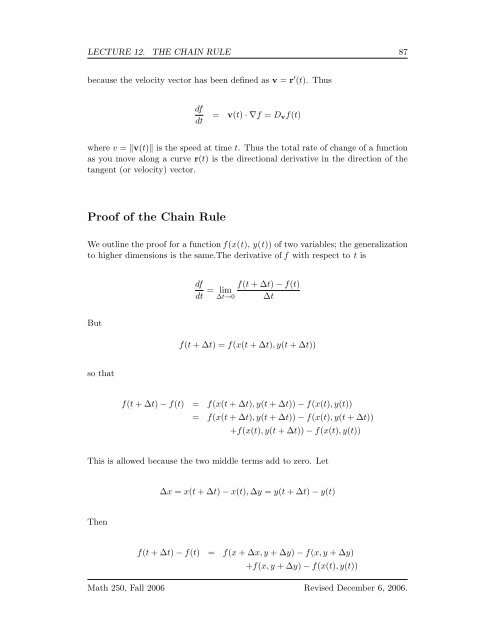Multivariate Calculus - Bruce E. Shapiro
Multivariate Calculus - Bruce E. Shapiro
Multivariate Calculus - Bruce E. Shapiro
You also want an ePaper? Increase the reach of your titles
YUMPU automatically turns print PDFs into web optimized ePapers that Google loves.
LECTURE 12. THE CHAIN RULE 87<br />
because the velocity vector has been defined as v = r ′ (t). Thus<br />
df<br />
dt<br />
= v(t) · ∇f = D v f(t)<br />
where v = ‖v(t)‖ is the speed at time t. Thus the total rate of change of a function<br />
as you move along a curve r(t) is the directional derivative in the direction of the<br />
tangent (or velocity) vector.<br />
Proof of the Chain Rule<br />
We outline the proof for a function f (x(t), y(t)) of two variables; the generalization<br />
to higher dimensions is the same.The derivative of f with respect to t is<br />
df<br />
dt = lim f(t + ∆t) − f(t)<br />
∆t→0 ∆t<br />
But<br />
f(t + ∆t) = f(x(t + ∆t), y(t + ∆t))<br />
so that<br />
f(t + ∆t) − f(t) = f(x(t + ∆t), y(t + ∆t)) − f(x(t), y(t))<br />
= f(x(t + ∆t), y(t + ∆t)) − f(x(t), y(t + ∆t))<br />
+f(x(t), y(t + ∆t)) − f(x(t), y(t))<br />
This is allowed because the two middle terms add to zero. Let<br />
∆x = x(t + ∆t) − x(t), ∆y = y(t + ∆t) − y(t)<br />
Then<br />
f(t + ∆t) − f(t) = f(x + ∆x, y + ∆y) − f(x, y + ∆y)<br />
+f(x, y + ∆y) − f(x(t), y(t))<br />
Math 250, Fall 2006 Revised December 6, 2006.
















